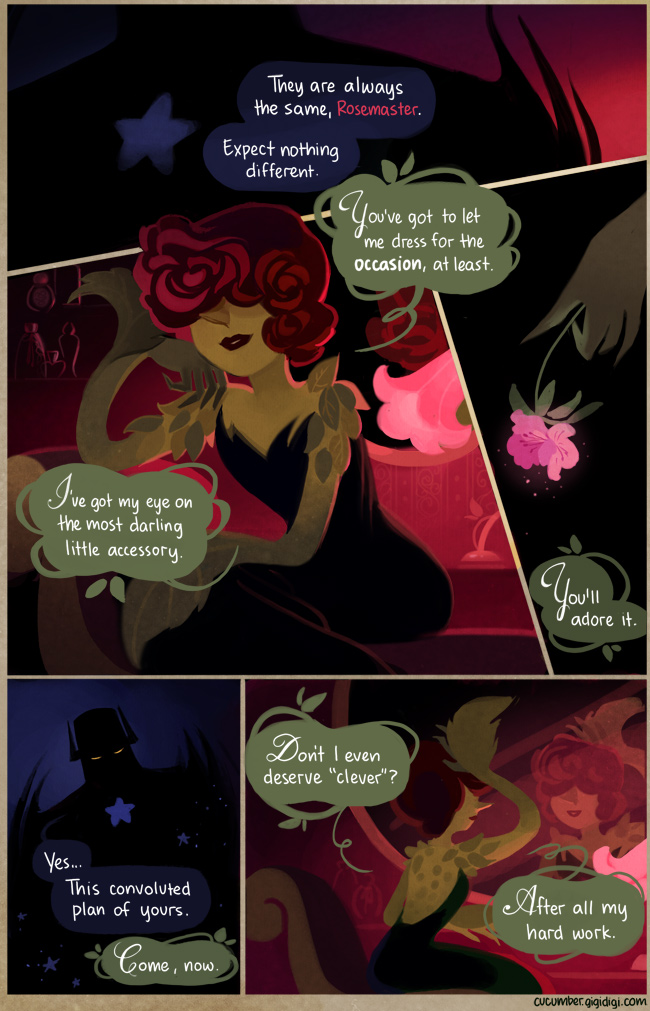From long-running soap operas to comedy-drama slices of life to daily gag strips, the digital comics scene has exploded over the last decade and readers have never had more options. Feeling overwhelmed? Jen Overstreet and Joe Stando are here to take you on an expedition through the webcomics wilderness and show you the best specimens in our monthly Deadshirt Webcomics Field Guide.
Sometimes I think that the most successful fictions are the ones written for all ages. If your story has the simplicity to make sense to kids, yet stays smart and interesting enough to appeal to adults, you end up with a story that is perpetually accessible, and open to the increased meaning we bring back to it as we get older and more experienced. Gigi D.G.’s Cucumber Quest is an all-ages epic romp. Its characters are bunny people! (And the occasional cat or pig.) The colors are bright and inviting, the characters charming, and the gags plentiful. The plot of Cucumber Quest moors readers in a simple, recognizable fantasy storyline full of tropes, then gently tears at the seams both with comedy and seriousness, opening up a unique take on adventure.
Cucumber Quest begins as a clear take on the archetypal Hero’s Quest. In the world of Dreamside, the interloper Cordelia, set on world domination, usurps the throne of the Doughnut Kingdom and gathers the eight Disaster Stones in order to summon an ancient evil. The extremely reluctant titular hero, Cucumber, is right about to start magic school when he is summoned by his imprisoned father to ditch his education and save the world. Cucumber meets the mysterious and flaky Dream Oracle, who names him the Legendary Hero and tells him to find the Dream Sword. With the help of his actually action-inclined sister Almond, Cucumber sets off to meet many strange enemies, quirky companions, and a bizarrely genteel ancient evil.
The legend of the quest resembles the chaptered structure of a video game. To use the Dream Sword, Cucumber must visit the princess of each of seven kingdoms. There are eight Disaster Masters to fight, all of whom seem to be lying in wait to play boss level at each kingdom. As adventurers unaware of the storytelling structure in which they’re a part, the characters frequently find themselves butting up against the arbitrary logic of videogame progression and fantasy tropes. Almond can’t be the legendary hero even though she’s much more suited to it because she’s a girl. The ancient evil, the Nightmare Knight, splits his powers into ineffective Disaster Masters for no apparent reason. The Dream Oracle is weirdly elusive and leaves out key, helpful information. Creepy engineer Cosmo shows up every time the plot could use some rapid transport between kingdoms.
Not only does Cucumber Quest poke fun at these devices as the story unravels, but the arbitrary structure of the quest becomes the weirdness that hints at deeper currents running through this conflict. The key players in this dance stop playing their parts as unthinkingly as they are supposed to, and begin to ask questions. They try to talk things out when they’re meant to fight. They interfere with their own boss’s plans in order to flirt with the opposition. They tacitly provide aide to the bunnies they’re supposed to destroy.
Gigi D.G. shows an incredible sense of color and light in her artwork. The strength of the artwork is extremely consistent across four years’ worth of comic. The prologue features rougher linework that quickly tightens up within the first full episode, but even this seems fitting with the story itself. Cucumber Quest starts in broad strokes, becoming increasingly detailed and textured. From there on the artwork changes mostly in subtle shifts that reflect the environment and tone of the current Kingdom or sidequest. In a sidequest in which the characters are forced by a narcissistic kidnapper into participating in a play, the colors and linework have a slightly fuzzy, Vaseline glow. When fighting the DJ-themed Disaster Master Noisemaster, the linework is sharp and stark in acidic neons on black. In the current Rosemaster plotline, the coloring is darker and more subdued than usual, and has more texture, a painterly quality that complements Rosemaster’s dark elegance.
Juxtaposed, the Noisemaster and Rosemaster plots show the stark contrast in their color and line, tailored to fit to each plot’s central villain.
D.G. uses pacing and “volume” (via lettering size) in conjunction with her expressive artwork to create a very theatrical physical humor. A character sneaks in a contrarian comment in a small word balloon behind some regular-size exposition. Extra beats of silence before delayed reactions add awkwardness and ridiculousness to comedic dialogue.
Long-form webcomics face a particular challenge in the once-or-twice-a-week update schedule. A many-page story can be difficult to follow a single page at a time, and even that unit may not make sense without the rest of the story for context. Cucumber Quest balances this effectively, however, with dynamic single-page compositions, and frequent enough single-page gags within the flow of the plot’s long game to keep reader attention. There’s a comfortable give-and-take between epic pacing and sitcom-esque comedy beats.
As a cute comedic bunny story for all ages, Cucumber Quest has a casualness that conceals a smart and engrossing adventure drama. It delivers delightful characters both good and evil in a world of rich color and illumination.
Cucumber Quest currently updates twice a week. Be sure to check out our previous Webcomics Field Guides.








Tiny correction: Thanks to the latest Kickstarter reaching $100,000, the update schedule is currently a less consistent but much faster pace of “whenever, but at least three times a week”.